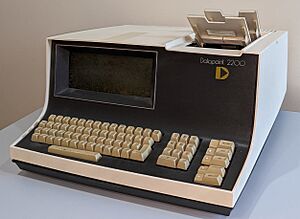Datapoint 2200 facts for kids

Datapoint 2200 computer
|
|
| Manufacturer | Computer Terminal Corporation |
|---|---|
| Type | Intelligent terminal, personal computer |
| Release date | May 1970 |
| Discontinued | 1979 |
| Operating system | Datapoint O/S |
| CPU | serial, discrete logic implementation of the Intel 8008 instruction set |
| Memory | 2 KB standard; expandable to 16 KB |
| Display | Text only, 80×12 characters |
The Datapoint 2200 was a special kind of computer that came out in 1970. It was designed by Phil Ray and Gus Roche from a company called Computer Terminal Corporation (CTC). At first, it was sold as a smart computer terminal that could connect to big mainframes. It could even pretend to be different types of terminals by loading special programs from tape.
But then, a salesman named Dave Gust realized it could be used as a small, stand-alone computer. This was perfect for companies like Pillsbury Foods. Some people even say the designers always meant for it to be a full personal computer. They just kept it a secret so investors wouldn't worry!
The Datapoint 2200 was very important for another reason. Its main brain, called the CPU, had a special set of commands. These commands later became the basis for the Intel 8008 and Intel 8080 chips. These chips then led to the x86 instruction set. This is the same basic set of commands used in most computers today, like the original IBM PC and its modern versions.
Contents
What Was the Datapoint 2200 Like?
The Datapoint 2200 looked a bit like a big typewriter. It had a keyboard built right in. It also had a green screen that could show 12 lines of text with 80 characters each.
For storing information, it had two cassette tape drives. Each tape could hold about 130 KB of data. Later, you could also get a hard disk drive that held 2.5 MB. Other options included modems for connecting over phone lines, printers, and even a punched card reader. Later, an 8-inch floppy disk drive became available too.
In 1977, Datapoint also introduced ARCNET, which was an early way to connect computers in a LAN.
How Much Memory Did It Have?
The first version of the Datapoint 2200 came with 2 KB of memory. This could be expanded to 8 KB. A later version, called Type 2, used newer memory chips. It started with 4 KB of memory and could go up to 16 KB.
When it first came out, the Datapoint 2200 cost about US$5,000. A fully loaded Type 2 model with 16 KB of memory cost over $14,000.
How Did Its Processor Work?
The Datapoint 2200's brain, or processor, was designed to handle information 8 bits at a time. This design was built using many small electronic parts called TTL components. Interestingly, the way it handled data, starting with the smallest part of a number, is still used in most laptops and cloud computers today! This is called "little-endian" format.
The Datapoint 2200 models were later replaced by newer versions like the 5500, 1100, and 6600.
The Start of the x86 Computer Family
The people at CTC originally wanted a single computer chip to be the brain of the Datapoint 2200. In 1969, they asked two companies, Intel and Texas Instruments, to make this chip. Texas Instruments couldn't make a reliable chip, so they stopped. Intel also missed the deadline.
So, CTC decided to build the Datapoint 2200 using about 100 smaller TTL chips instead of one big microprocessor. Intel eventually finished their single-chip design in April 1972. This chip was named the Intel 8008.
Even though the Datapoint 2200 used many small chips and processed data one bit at a time, it was actually quite fast. In fact, it was faster than the Intel 8008 chip that came out later! Because of this speed, Datapoint kept building their computers with TTL chips until the early 1980s.
However, the Intel 8008 was still very important. It became the first in a line of 8-bit CPUs from Intel. These led to their 16-bit CPUs, which were the first members of the x86 family. The x86 family became super popular after the IBM PC came out in 1981 with an Intel 8088 CPU. This means that most desktop, laptop, and server computers you use today have a CPU that uses commands directly based on the work of the Datapoint 2200 engineers!
The Zilog Z80 microprocessor, which was also very successful, can trace its roots back to the Datapoint 2200 as well. This is because the Z80 could run programs made for the Intel 8080, which was inspired by the 8008.
Who Designed It?
The basic set of commands for the Datapoint 2200's processor was created by Victor Poor and Harry Pyle. The actual design using the many small TTL chips was done by Gary Asbell. The way the computer looked on the outside, including the company's logo, was designed by Jack Frassanito.
Specifications
Here are some details about the Datapoint 2200:
Main unit
- Processor: An 8-bit CPU that processed data one bit at a time. It was built from standard TTL parts. The Intel 8008 was a very similar 8-bit design that fit on one chip.
- Memory: Started with 2 KB of memory, could be expanded to 8 KB. (Later versions, Type II, started with 4 KB and could go up to 16 KB).
- Display: Showed only text, 80 characters wide by 12 lines tall.
- Storage: Came with two tape drives. An optional 8-inch Shugart floppy drive was also available later.
Extra Parts (Peripherals) Users could add several optional units to their Datapoint 2200:
- Modems (for connecting to other computers)
- Hard disks (for more storage)
- Printers (to print documents)
- ARCnet LAN (for connecting computers in a network)
See also
- Kenbak-1

